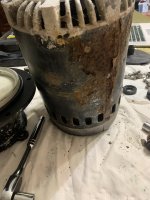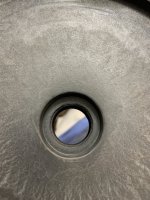This pump, like much of everything else in my pool setup, has not been well cared for. The impeller has recently broken off (due to a combination of debris getting in from a cracked filter manifold as well as highly chlorinated water resting inside the pump cavity weakening the material) and needed replacement. Purchased the correct part (new style) and was told to replace the PS-1000 seal as well, so purchased that too. The pump is also 'squealing' so I decided it will unfortunately mean replacing the internal bearings+lubricant. Some questions:
1. I found this ripped foam washer/cushion sitting inside the Motor Bracket...can't seem to find it in any of the part diagrams. Where does it go, and is it needed? edit: it's a Water Slinger, had to purchase a similar one from a different model.
2. The PS-1000 seal that I purchased is a loose fit...I presume I instead need a 3/4" seal as this gap is intolerable? Can someone link the correct part? The Top Spring Seal also appears to be different... edit: PS-1000 part was recommended for primary Pentair pump, not this one. Purchasing 3/4" seal
3. Will mild rust stains on the shaft be an issue? It is smooth and uniform to the touch. edit: going to use super fine steel wool on it and then call it a day
4. The bottom of the body has considerable rusting...but it appears mostly cosmetic; still solid, and top of unit is fine. I intend to proceed with repair unless someone tells me that this could explode at any moment (clearly not so, but I'll listen) edit: going to brush off loose rust and spray paint affected area with Rustoleum Flat Protective Enamel
5. Following a PoolZoom Rebuild Guide (that doesn't open up the actual motor) as well as a comprehensive LS YT Video; the poolroom guide mentions adhering the top spring seal with silicone (Under the 'Installing The New Shaft Seal' section). Is this necessary? Edit: Will put a touch of silicone, why not
Going to buy 6203-2RS Bearings, this Bearing Removal Tool, and some kind of lubricant for the bearings.
6. Is '2/3 Jaw | 6-1/4" Spread | 5-1/2" Reach' enough to remove the bearings? edit: I really hope so, that's what I have
7. What lubricant do I buy?? edit: not even sure lubricant is needed, have some Quicksilver Marine Grease 2-4-C w/ PTFE I will put in the bearing socket
1. I found this ripped foam washer/cushion sitting inside the Motor Bracket...can't seem to find it in any of the part diagrams. Where does it go, and is it needed? edit: it's a Water Slinger, had to purchase a similar one from a different model.
2.
3. Will mild rust stains on the shaft be an issue? It is smooth and uniform to the touch. edit: going to use super fine steel wool on it and then call it a day
4. The bottom of the body has considerable rusting...but it appears mostly cosmetic; still solid, and top of unit is fine. I intend to proceed with repair unless someone tells me that this could explode at any moment (clearly not so, but I'll listen) edit: going to brush off loose rust and spray paint affected area with Rustoleum Flat Protective Enamel
5. Following a PoolZoom Rebuild Guide (that doesn't open up the actual motor) as well as a comprehensive LS YT Video; the poolroom guide mentions adhering the top spring seal with silicone (Under the 'Installing The New Shaft Seal' section). Is this necessary? Edit: Will put a touch of silicone, why not
Going to buy 6203-2RS Bearings, this Bearing Removal Tool, and some kind of lubricant for the bearings.
6. Is '2/3 Jaw | 6-1/4" Spread | 5-1/2" Reach' enough to remove the bearings? edit: I really hope so, that's what I have
7. What lubricant do I buy?? edit: not even sure lubricant is needed, have some Quicksilver Marine Grease 2-4-C w/ PTFE I will put in the bearing socket
Attachments
Last edited:












